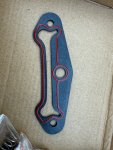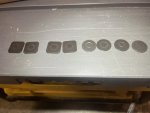- 2,592
- 6,215
- 113
- Location
- Portland, OR
No. Installed dry. Same with the head gasket.Do you guys recommend any type gasket sealant/adhesive on the unloader gasket?
Steel Soldiers now has a few new forums, read more about it at: New Munitions Forums!

No. Installed dry. Same with the head gasket.Do you guys recommend any type gasket sealant/adhesive on the unloader gasket?

Thanks. Yes, the surfaces are flat. I used copper coat on the cork gasket I made initially. I will install the other gasket I have and see if that fixes the issue. If not, then I'll try the copper coat.Are the surfaces flat? I use a flat file to draw file mating surfaces flat(pull file perpendicular to the long axis of the file like a draw knife), to reduce any raised areas… For paper gaskets I have used a spray sealant called copper coat for decades when needed. Hang the gasket on a hook and spray both sides and allow it to tack up then install the gasket..

I got the tool about 2 years ago, if you want to make one I have some measurements.What is everyone using for an Inlet Valve Cage tool?
When you refer to Haldex, are you also including the Midland brand compressor for spring failures?You should at least rebuild the compressor cylinder head. Without exception, EVERY SINGLE ONE of these FMTV Haldex compressors I have opened up has broken exhaust valve springs. I came to this realization when the disc in one of my exhaust valves broke in half and slipped down into the cylinder - it punctured a hole in the compressor piston, scored up the cylinder wall, and beat the hell out of the head in that cylinder. I pulled the compressor but it ended up not even being rebuildable when the crankshaft broke trying to get the drive gear retaining nut off. I had to find a core to rebuild and get up and running again. Since that experience in 2021 I have opened up about five or six compressors and every one has had heat damaged exhaust valve springs that were broken into between 3 and 10 pieces and the discs have circles worn deeply into them from bouncing and rattling on the seat.
I carry a rebuilt cylinder head on board my truck as a spare after these experiences. It's only about $100 for the kit to rebuild them (includes the head gasket) and it's 6 bolts to swap it out on the truck. Takes maybe an hour tops. You are absolutely screwed if you have a failure like I had with a hole in a piston since that causes the compressor to push compressed air (under turbo-charger boost pressure) directly into the engine crankcase and it will blow oil out of the engine breather and likely cause other problems with gaskets and seals. Finding one of these compressors out in the field is very difficult - they are not the normal compressor spec'd by CAT. Those are only about 15 CFM. This is a military spec'd compressor that is 18 CFM - the assumption being the emergency mode of the CTIS system, and in general the military wants the air system to get the troops back from the field even with leaking hoses, etc. But you can't (easily) adapt something else in it's place since the power steering hydraulic pump is driven off the back and the support bracket is very specifically located and sized to run that exact pump - and without that brace you will crack the timing case as the entire weight of the compressor and hydraulic pump would be hanging off it by two bolt...... it's not something you want to deal with away from home. Thus my spare cylinder head and also monitoring wet tank inflation time at idle as a metric to ascertain compressor pumping efficiency and head-off any impending valve issues before they end in catastrophe.
The unloader piston o-rings also go hard/square and leak causing the unloader signal from the wet tank to leak wet tank air back through the unloaded intake valves. This is an insidious failure since it's invisible - the unload air signal leaks back into the engine intake.
In addition to ALL that - the new style Haldex PUREst dryer had a running change from a 150 psi relief valve to a 175 psi relief valve. I noticed that the 150 valve on mine would regularly open if I was under boost when the dryer purged. Partially due to it being spec'd too low and partially because my engine is juiced up to 370 HP and thus is running significantly higher boost pressure - and the compressor is fed air from the intake manifold post-intercooler where it's getting 30+ psi above atmospheric which is fed directly to the dryer when it unloads and the path between turbo and dryer is completely open.
Same thing. Haldex owns Midland. All FMTV's use the same compressor.When you refer to Haldex, are you also including the Midland brand compressor for spring failures?
I have to admit, I have never rebuilt one of these. I am doing preemptive head rebuild of a Midland this week. I have the compressor out to add the A/C PITA bracket. Any pointers for the valve and spring replacement? I found some videos on this, but most kind of blew through it pretty fast.Same thing. Haldex owns Midland. All FMTV's use the same compressor.
